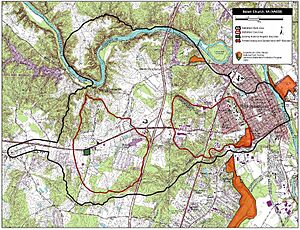Battle of Salem Church facts for kids
Quick facts for kids Battle of Salem Church(Battle of Banks' Ford) |
|||||||
|---|---|---|---|---|---|---|---|
| Part of the American Civil War | |||||||
 Attack on Gen. Sedgwick's Corps, seen from the north bank of the Rappahannock River. Forbes, Edwin, artist, May 4, 1863. |
|||||||
|
|||||||
| Belligerents | |||||||
| Commanders and leaders | |||||||
| John Sedgwick | Robert E. Lee | ||||||
| Units involved | |||||||
| VI Corps, Army of the Potomac | Army of Northern Virginia | ||||||
| Strength | |||||||
| 23,000 | 10,000 | ||||||
| Casualties and losses | |||||||
| 4,611 | 4,935 | ||||||
The Battle of Salem Church was a fight during the American Civil War. It happened on May 3 and 4, 1863, in Spotsylvania County, Virginia. This battle was part of a larger series of fights known as the Chancellorsville Campaign. It is also sometimes called the Battle of Banks' Ford.
Contents
What Led to the Battle?
After a fight at Marye's Heights, Union Maj. Gen. John Sedgwick and his VI Corps (about 23,000 soldiers) began marching. Their goal was to meet up with their commander, Maj. Gen. Joseph Hooker, at Chancellorsville.
On May 3, Sedgwick's troops were slowed down. They faced a Confederate group led by Brig. Gen. Cadmus M. Wilcox. This group was part of Jubal A. Early's forces. The Union soldiers stopped near Salem Church for the night.
Meanwhile, Confederate Gen. Robert E. Lee learned about Sedgwick's advance. Lee quickly sent a division of soldiers, led by Lafayette McLaws, to Salem Church. McLaws's troops arrived around noon, joining Wilcox. They were also joined by William Mahone's group from Richard H. Anderson's division.
The Armies Involved
Union Forces
The Union army involved was mainly John Sedgwick's VI Corps. This corps was part of the larger Army of the Potomac. They had about 23,000 soldiers.
Confederate Forces
The Confederate army was made up of parts of Robert E. Lee's Army of Northern Virginia. Key groups included Lafayette McLaws's division and parts of Richard H. Anderson's division. They had around 10,000 soldiers.
The Battle Unfolds
At first, General Sedgwick thought he was only fighting a small group of Confederate soldiers. So, around 3:30 p.m., he ordered William T. H. Brooks's division to attack. Brooks's soldiers pushed back the Confederates on their right side.
However, the Confederates quickly fought back. This counterattack stopped the Union advance. Brooks's division had to fall back to where they started. The fighting ended for the day as the sun set. During the night, General Lee planned his next moves. He ordered Early to attack Sedgwick's left side in the morning. McLaws would attack the Union right.
Sedgwick did not receive clear orders from his commander, Hooker. He was only told he could retreat if he felt it was needed.
On May 4, at 7 a.m., Early's Confederate troops attacked again. They managed to take back Marye's Heights. Then, they moved west towards Sedgwick's main lines. They stopped when they met heavy Union fire. For the rest of the morning, Early launched several attacks. But these attacks were not well-coordinated and were all defeated.
By 11 a.m. on May 4, General Sedgwick found himself in a tough spot. He was facing Confederate forces from three directions. Lee's main army was to his west, Anderson's division to his south, and Early's division to his east. Sedgwick heard rumors that more Confederate soldiers were arriving. This made his situation even harder.
His battle line was six miles long, held by 20,000 Union troops. They were fighting against 25,000 Confederates, with more possibly coming. Sedgwick's corps had already suffered over 5,000 casualties. He only had one bridge to retreat across if things went wrong. He told General Hooker about his difficult situation. He asked for help from the main Union army. But General Hooker replied that Sedgwick should not attack unless the main army did too.
Meanwhile, General Lee arrived at McLaws's headquarters at 11 a.m. McLaws told Lee that his troops were not strong enough to attack. He asked for more soldiers. Lee then ordered Anderson to bring his other three brigades. They were placed between McLaws and Early. Anderson launched more attacks, but these were also defeated.
General Benham of the U.S. Engineering Corps had built a bridge at Scott's Dam. This helped with communication with General Hooker. When a retreat was planned, General Benham added a second bridge on May 4. He and General Sedgwick agreed to cross the river at night. This would help them avoid losing many soldiers. At 6 p.m. on May 4, the final Confederate attack happened and was pushed back. The Union 6th Corps began moving back to a smaller defense line closer to the bridges. They started their retreat without losing any more soldiers.
What Happened Next?
After dark, Sedgwick sent a message to Hooker. He suggested that the VI Corps should retreat across the river. Hooker agreed at 1 a.m. Sedgwick's troops then crossed two pontoon bridges at Banks' Ford. The retreat was finished around 4 a.m.
When Hooker heard that Sedgwick had been pushed back, he decided to end the entire campaign. The main Union army crossed back to the north bank of the Rappahannock River. They returned to their camp at Falmouth on the night of May 5 into May 6.


